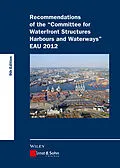The "EAU 2012" takes into account the new generation of standards, which is shortly to be introduced into the building control system; it consists of Eurocode 7, the associated national application documents and additional national regulations (DIN 1054:2010). In certain cases, partial safety factors are determined differently based on experience in practice. This means that the safety standard of sea and port buildings remains in place; the recommendations nevertheless satisfy the requirements for international recognition and application regarding the planning, design, specification, tender procedure, construction and monitoring, as well as the handover of - and cost accounting for - port and waterway systems under uniform criteria.
Autorentext
The working committee (short title: "Bank reinforcements") has been working on a voluntary basis as a committee of the Hafenbautechnische Gesellschaft e. V., Hamburg (HTG) since 1949, and since 1951, simultaneously as Working Committee 2.2 of the Deutsche Gesellschaft für Geotechnik e. V., Essen (DGGT). Its full title is "Committee for the simplification and unification of the calculations and design of bank reinforcements".
Klappentext
EAU 2012 represents a completely updated edition of the Recommendations of the Committee for Waterfront Structures Harbours and Waterways. It provides those working in this field with a valuable work of reference for design, tendering, award of contract, engineering tasks, economically and environmentally compatible construction, site supervision and contractual procedures. The recommendations correspond to the latest international findings and form the foundation for building ports, harbours and waterways according to the state of the art and with consistent specifications. By incorporating the European standardisation concept, the 9th edition of the English version of the recommendations satisfies the requirements for notification by the European Commission.
The Waterfront Structures Working Committee has been working on a voluntary basis under the auspices of the HTG (German Port Technology Association) since 1949 and as Study Group 2.2 of the DGGT (German Geotechnical Society) since 1951.
Inhalt
List of Recommendations in the 9th Edition XXI
Preface to 11th, revised edition (9th English edition) of the Recommendations of the Committee for Waterfront Structures Harbours and Waterways XXVII
0 Structural calculations 1
0.1 General 1
0.2 Safety concept 2
0.2.1 General 2
0.2.2 Combination factors 7
0.2.3 Analysis of ultimate limit state 8
0.2.4 Analysis of serviceability limit state 9
0.2.5 Geotechnical categories 9
0.2.6 Probabilistic analysis 9
0.3 Calculations for waterfront structures 10
1 Subsoil 11
1.1 Mean characteristic values of soil parameters (R 9) 11
1.1.1 General 11
1.2 Layout and depths of boreholes and penetrometer tests (R 1) 11
1.2.1 General 11
1.2.2 Principal boreholes 17
1.2.3 Intermediate boreholes 17
1.2.4 Penetrometer tests 17
1.3 Geotechnical report (R 150) 18
1.4 Determining the shear strength cu of saturated, undrained cohesive soils (R 88) 19
1.4.1 Cohesion cu of undrained soil 19
1.4.2 Determining the cohesion cu of an undrained soil 20
1.4.3 Determining cu in laboratory tests 21
1.4.4 Field tests 22
1.4.5 Correlations 22
1.5 Assessing the subsoil for the installation of piles and sheet piles and for selecting the installation method (R 154) 22
1.5.1 General 22
1.5.2 Assessment of soil types with respect to installation methods 23
2 Active and passive earth pressure 27
2.1 General 27
2.2 Considering the cohesion in cohesive soils (R 2) 27
2.3 Considering the apparent cohesion (capillary cohesion) in sand (R 3) 27
2.4 Determining active earth pressure according to the Culmann method (R 171) 28
2.4.1 Solution for uniform soil without cohesion 28
2.4.2 Solution for uniform soil with cohesion 29
2.4.3 Expanded solutions 29
2.5 Active earth pressure in stratified soil (R 219) 30
2.6 Determining active earth pressure for a steep, paved embankment in a partially sloping waterfront structure (R 198) 32
2.7 Determining the active earth pressure shielding on a wall below a relieving platform with average ground surcharges (R 172) 34
2.8 Earth pressure distribution under limited loads (R 220) 37
2.9 Determining active earth pressure in saturated, non- or partially consolidated, soft cohesive soils (R 130) 38
2.10 Effect of artesian water pressure under harbour bottom or river bed on active and passive earth pressures (R 52) 40
2.11 Considering active earth pressure and excess water pressure, and construction guidance for waterfront structures with soil replacement and contaminated or disturbed base of excavation (R 110) 42
2.11.1 General 42
2.11.2 Approach for determining active earth pressure 42
2.11.3 Approaches for determining excess water pressure 44
2.11.4 Guidance for the design of waterfront structures 44
2.12 Effect of groundwater flow on excess water pressure and active and passive earth pressures (R 114) 46
2.12.1 General 46
2.12.2 Determining the excess water pressure 48
2.12.3 Determining the effects on active and passive earth pressures when the flow is mainly vertical 50
2.13 Determining the amount of displacement required for mobilising passive earth pressure in non-cohesive soils (R 174) 53
2.14 Measures for increasing the passive earth pressure in front of waterfront structures (R 164) 54
2.14.1 General 54
2.14.2 Soil replacement 55
2.14.3 Soil compaction 55
2.14.4 Soil surcharge 56
2.14.5 Soil stabilisation 56
2.15 Passive earth pressure in front of abrupt changes in ground level in soft cohesive soils with rapid load application on land side (R 190) 57
2.16 Waterfront structures in seismic regions (R 124) 57
2.16.1 General 57
2.16.2 Effects of earthquakes on the subsoil 59
2.16.3 Determining the effects of earthquakes on active and passive earth pressures 59
2.16.4 Excess water press...
